How To Bypass A Window Ac Control Board
How to Repair the Virtually Common Air Conditioner Problems Yourself
Our experts explain how to repair the most mutual causes of central air conditioning service failures.
Introduction
Our experts shows yous easy DIY solutions for the most mutual central ac repairs. You lot'll be up and running sooner and will salve the expense of a service phone call.
Tools Required
Materials Required
- Capacitor
- Compressed air
- Condenser fan motor
- Contactor
- Fuses
DIY Air Conditioning Service Repair
If you central ac organisation stops working during a brutal summer heat wave, you could exist waiting days, if non weeks, for an date with a repair technician to fix it, and it's probably going to cost a few hundred dollars. Even so, if y'all're comfortable working around electricity and willing to spend less than $100 on parts, you tin probably repair your air conditioner yourself in about two hours.
We talked to local HVAC repair technicians to get their best exercise-it-yourself Air-conditioning fan repair and maintenance tips. These tips volition assist you with the most common "depression cooling" and "no cooling" problems.
You'll need a few basic tools: multimeter, a voltage detector, an assortment of insulated screwdrivers and a socket set.
If these Air-conditioning repairs don't work, at least you've covered the most common failures, and your service guy tin concentrate on finding the more elusive problem. Plus, with the new parts, you'll probable add years of breakup-free ac. Hither's how to get-go.
Why Is My Air Conditioner Not Cooling the House?
Make Certain the Problem Isn't the Furnace
Set your thermostat to Ac mode and lower the temperature setting. If the furnace fan kicks in, the problem isn't in the furnace. If the fan doesn't run, try resetting the furnace excursion billow. If the fan still won't start, phone call a pro — the fixes shown here won't work.
Side by side, bank check the outside condensing unit. The compressor (which sounds like a refrigerator) and fan should be running. If non, follow the troubleshooting and repair procedures shown here.
Circumspection: Turn Off the Ability
Turn off the A/C and furnace breakers in the chief electric panel before pulling the outdoor disconnect or removing the condensing unit's access console. Then apply a voltage tester on the wires coming into the contactor to make certain the ability is actually off.
AC Doesn't Work? Buy Parts
The AC contactor (relay) and start/run capacitor(s) (see analogy beneath) neglect most often and are cheap. So it's a safe bet to purchase and install those parts right away, especially if your air workout service unit is older than five years. The condenser fan motor tin also fail, but it runs about $150 — hold off buying that unless you're sure that'south the culprit.
To buy replacement parts, notice the nameplate on the condensing unit of measurement (not your furnace). Jot down the make, model and serial number (or take a photograph). Go the parts at an appliance store, furnace dealer or online.
Project stride-by-step (eight)
Pace ane
Acquire the Beefcake of a Central Home Air Conditioner
Central habitation air conditioner service systems consist of two major components: a condenser that sits outside your house and the evaporator coil (oftentimes referred to every bit an A-coil) that sits in the plenum of your furnace or air handler. The refrigerant in the A-coil picks up the heat from your home and moves it to the outdoor condensing unit. The condensing unit fan blows exterior air through the condensing ringlet to remove the rut. The condensing unit houses the three parts replaceable by a DIYer: the Air conditioning contactor, the start/run capacitor(s) and the condenser fan motor. The condensing unit also houses the compressor, but simply a pro tin can supersede that. The A-scroll has no parts that can exist serviced past a DIYer.
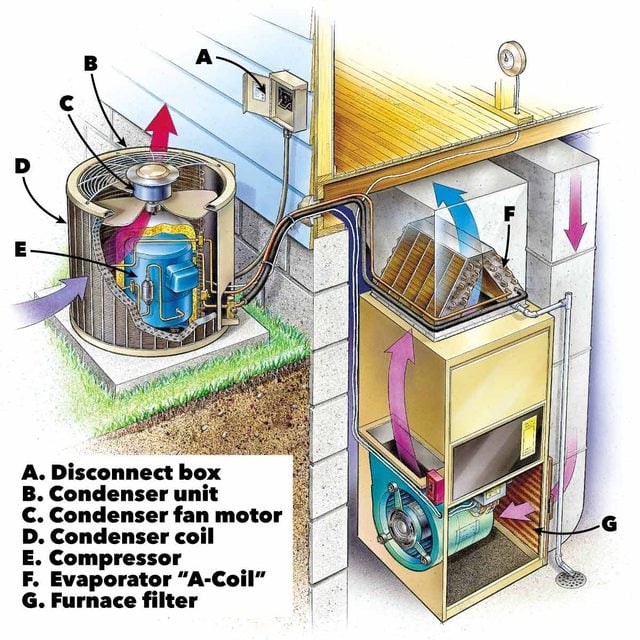
Footstep 2
Shut Off the Power
- Open the electrical box next to the condensing unit and pull the disconnect block directly out.
- Check inside the box with a voltage sniffer to make sure the ability is really off.
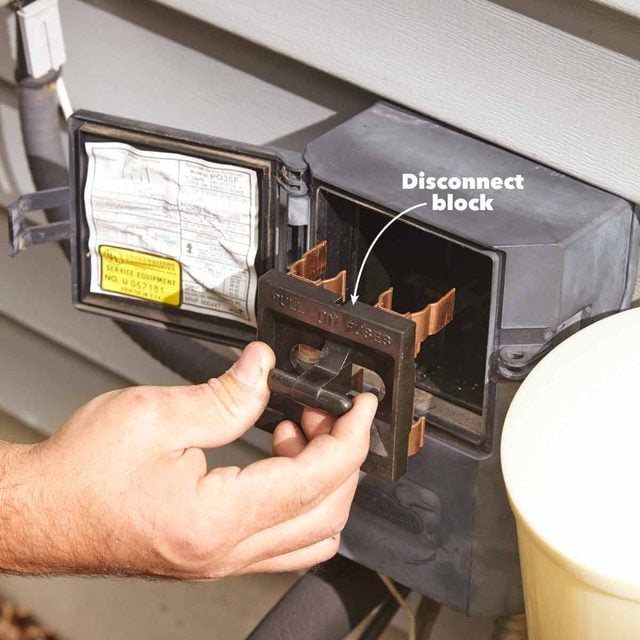
Pace 3
Clean the Condenser Coils
It's really easy to clean an air conditioner condenser, and information technology's one of the regular maintenance tasks that will extend the life of your unit.
- Aim your garden nozzle upward into the summit of the condenser scroll to remove the grime buildup nether the lid.
- Work all the way effectually the coil. Then aim the nozzle downwards and affluent the droppings downwards the scroll fins.
- Adapt the nozzle to a gentler stream and shoot h2o direct into the coils to flush out whatever remaining debris.
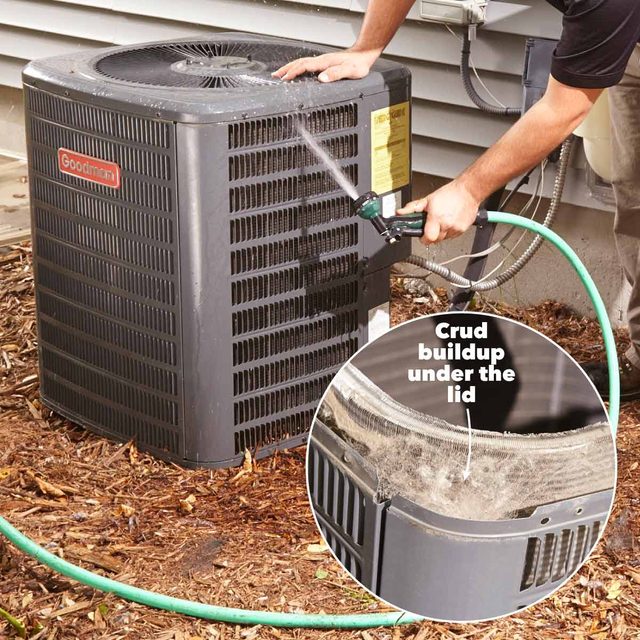
Step four
Exam the Fuses
Many disconnect blocks incorporate 2 cartridge fuses. Check them before you go on with repairs. A blown fuse is a sign of a failing role inside the condensing unit. And then don't just replace it and call up you've solved the problem. Instead, supervene upon the parts, install new fuses, and fire upwards the unit. If it blows once again, call a pro—you've got more serious issues.
How to Check Fuses In the Disconnect Block
- Set your multimeter to the lowest Ohms scale and touch the red and blackness leads to opposite ends of each fuse.
- If you get a numerical reading, the fuse is good.
- A zero, a minus symbol, or an infinity symbol (∞) indicates a blown fuse.
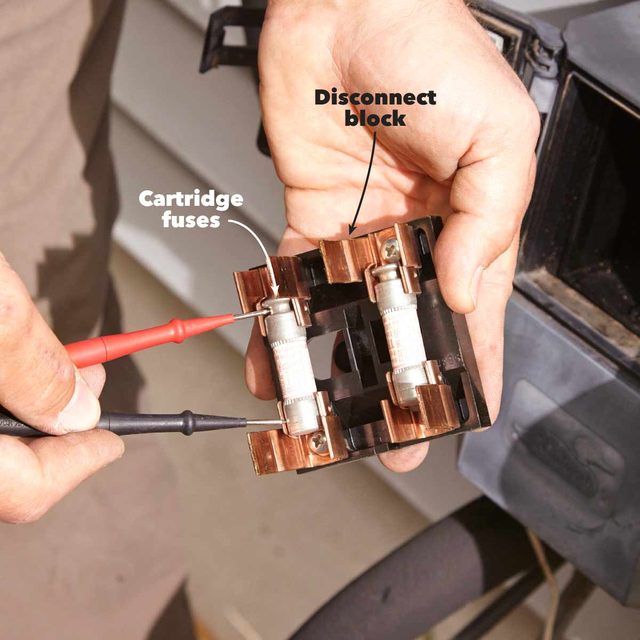
Step 5
Inspect the Within of the Admission Panel
Follow the electrical conduit from the house — that'south where you'll find the admission panel. With the power off, remove and store the admission-panel retaining screws and remove the panel. Before you replace whatsoever parts, check for rodents' nests or evidence of chewing on wires and electrical connectors.
If you find broken wires or chewed insulation and can safely handle electrical repairs, discharge the capacitor offset. Then repair the wires and clean out the nest. Otherwise, phone call a pro.
How to Discharge a Dual Showtime/Run Capacitor
- Remove the capacitor from the retaining bracket.
- Then touch an insulated screwdriver between the HERM (or "H") terminal and the Mutual (or "C") final.
- Do the same between the FAN (or "F") terminal and the "C" terminal.
- On single-mode capacitors, but make a brusque betwixt the 2 terminals.
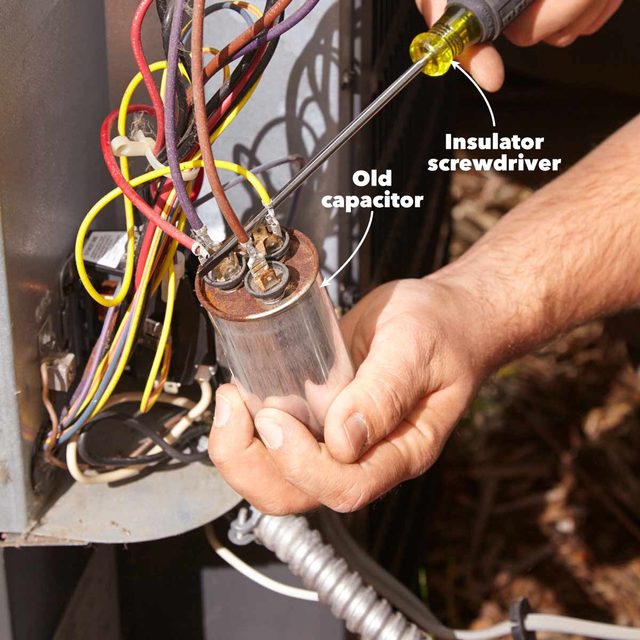
Pace half-dozen
Supercede the Get-go/Run Capacitor(s)
All air workout service units take at least ane capacitor. The capacitor stores electricity and releases information technology during compressor and condenser fan startup to give both motors an extra jolt of power. And it smooths out voltage fluctuations to protect the compressor and condenser fan motor from damage.
Capacitors can degrade slowly, providing less startup power over fourth dimension. Or they can fail in an instant. Gradual capacitor failure can go unnoticed for a long time, stressing the compressor and condenser fan motor windings, resulting in their early failure. Since capacitors are cheap, it pays to proactively replace yours about every five years.
How to Replace a Capacitator
- Take a photo of the wires earlier disconnecting annihilation (you may need a reference subsequently on).
- Discharge the stored energy in the sometime capacitor.
- Utilise needle-nose pliers to pluck one wire at a time from the old capacitor and snap it onto the corresponding tab of the new capacitor. The female crimp connectors should snap tightly onto the capacitor tabs.
- Wiggle each connector to see if information technology'southward tight. If it's not, remove the connector and bend the rounded edges of it so it makes a tighter fit on the tab.
- When you lot've swapped all the wires, secure the new capacitor.
Warning: Discharge the capacitor before disconnecting wires or removing it from its bracket.
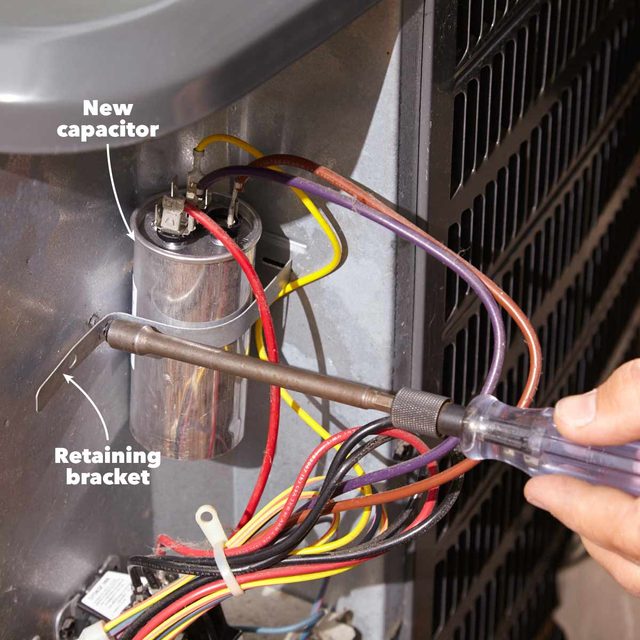
Footstep vii
Supervene upon the Air-conditioning Contactor
An AC contactor is a $25 mechanical relay that uses low-voltage ability from the thermostat to switch 220-volt high-amperage current to the compressor and condenser fan. AC contactors tin can wear out and are at the top of the listing of mutual air conditioning service failures. Fifty-fifty if your Ac contactor is working, it pays to supercede it every 5 years or so. Unscrew the old AC contactor earlier removing the wires. So move the wires to the new unit of measurement.
- Yank a connector off the old contactor and move it to the same location on the new role.
- Tighten the connectors where needed.
- Secure the new contactor in the condensing unit.
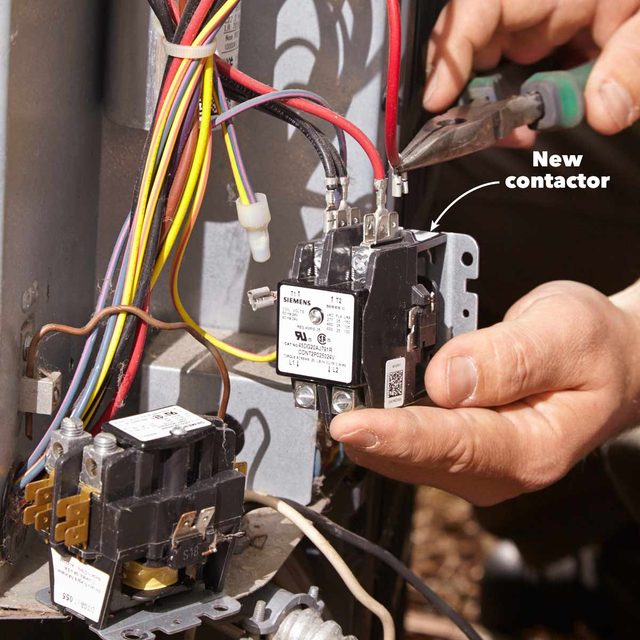
Stride 8
How to Test Your Repairs
- Reinstall the admission console and disconnect block.
- Turn on the circuit billow and furnace switch, so gear up the thermostat to a lower temperature and wait for the AC to start.
- The compressor should run and the condenser fan should spin.
- If the compressor starts but the fan doesn't, the fan motor is most likely shot.
- Shut off the ability and remove the screws around the condenser comprehend.
- Lift the comprehend and remove the fan blade and motor.
- Reinstall the blade and secure the embrace.
- So repower the unit and see if the fan starts.
- If it doesn't, yous've given it your all-time shot—information technology'south time to telephone call a pro.
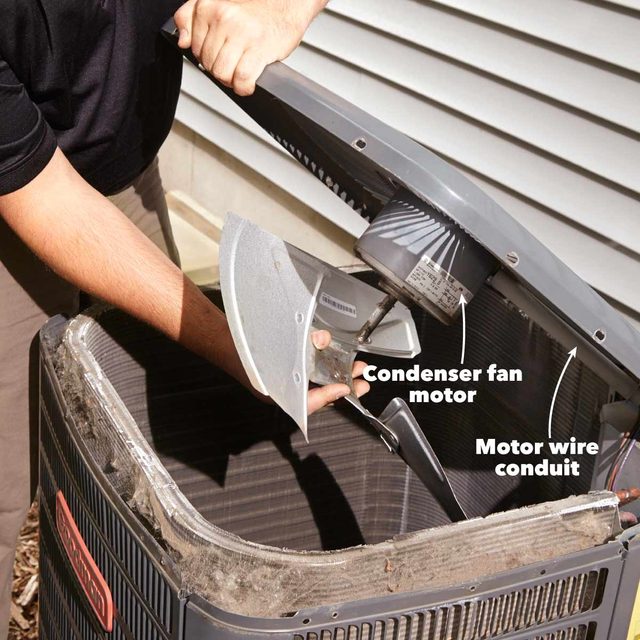
Exist Patient at Startup
AC units and thermostats have built-in delay features when they're shut downward and then repowered. The delay can be as long as 10 minutes. And, if you lot've subscribed to an free energy-saving device from your local power utility, the unit can take even longer to reset. If you've installed the parts shown and reinstalled the disconnect cake, repowered the circuit breaker, turned on the switch at the furnace, moved the thermostat to Air-conditioning mode and lowered the temperature below the indoor temperature, and the unit doesn't burn up after 30 minutes, it'south time to phone call a pro.
Originally Published: May twenty, 2019
Source: https://www.familyhandyman.com/project/diy-air-conditioner-repair/

0 Response to "How To Bypass A Window Ac Control Board"
Post a Comment